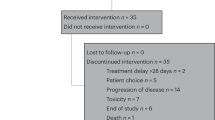We compared the effect of Xymedon (100 mg/kg), Mexidol (50 mg/kg), and their combination on spermatogenesis indicators and functional state of spermatozoa in rats with Walker-256 carcinoma treated with doxorubicin (4 mg/kg) and cyclophosphamide (45 mg/kg) (once intraperitoneally on day 11 after tumor cells transplantation). Xymedon and Mexidol were injected intramuscularly for 10 days starting from day 11 of the experiment. The studied parameters were evaluated on experimental days 14 and 21. We have established that gonadoprotective effect of Xymedon developed gradually and persisted longer than that of Mexidol. It manifested in an increase in the number of epithelial spermatogenesis cells (spermatogonia by 3.2 times, early spermatids by 2.2 times, late spermatids by 2.9 times, and Leydig cells by 4 times) in the testes and also the proportion of viable progressively and non-progressively motile epididymal spermatozoa (by 2 times). The combination of Xymedon and Mexidol stimulated spermatogenesis (with restoration of the initial level of spermatocytes, an increase in the number of early spermatids by 65.5 and 99% in comparison with Xymedon alone and Mexidol alone, respectively) and increased the number of viable epididymal spermatozoa more effectively than Xymedon and Mexidol alone by 54 and 60%, respectively.
Similar content being viewed by others
References
Bragina YY. Spermiologic examination protocol. Androl. Genit. Khir. 2014;15(1):15-24. https://doi.org/10.17650/2070-9781-2014-1-15-24
Voronina TA, Seredenin SB. Nootropes (cognition enhancers) and neuroprotectors. Eksp. Klin. Farmakol. 2007;70(4):44-58. Russian.
Vyshinskaya EA, Bespalov VG, Vasilyeva IN, Semenov AL, Stukov AN, Belyaeva OA, Kireeva GS, Maidin MA, Gershfeld ED, Belyaev AM. Advantages of intraperitoneal chemotherapy in treatment of ovarian cancer peritoneal carcinomatosis. Zh. Akush. Zhen. Bol. 2014;63(5):38-45. Russian.
Grek OR, Mishenina SV, Pupyshev AB. Protective effect of enterosgel on rat liver lysosomes during cytostatic treatment. Bull. Exp. Biol. Med. 2002;134(4):355-358.
Ivanov YuV. Cytological criteria of the state of spermatogenesis in toxicological and hygienic studies Gig. San. 1986;(4):52-55. Russian.
Kaplieva IV, Bordyushkov YN, Frantsiyants EM, Trepitaki LK, Petrusenko NA, Gorina II. Life expectancy and growth dynamics of tumors induced with 3,4-benzpyrene in rats under experimental autosplenochemotherapy. Fundament. Issled. 2014;(7-3):513-516. Russian.
Kidun KA, Ugolnik TS. Mitochondrial dysfunction of spermatozoa in the pathogenesis of pathosperm cells in oxidative stress (literature review). Probl. Zdorov’ya Ekol. 2013;(2):20-24. Russian.
Lutfullin МН, Garipov ТV, Shabalina ЕV. Evaluation of acute toxicity and cumulative effects of Xymedon hydrochloride. Ross. Parazitol. Zh. 2008;(2):80-83. Russian.
Masyagin VA, Siprov AV, Volkova ND, Kuznetsova VA, Shmyreva NV, Makarova MYu, Vashurkina IM. Comparative assessment of pyrimidine and 3-hydroxypyridine derivatives hematoprotective efficiency at the antitumor chemotherapy in experiment. Sovremen. Probl. Nauki Obrazovaniya. 2015;(3):190. Russian.
Siprov AV, Kostina YuA. Cardioprotective efficiency study of combination of pyrimidine and 3-hydroxypyridine derivatives in experimental antitumor chemotherapy. Saratov. Nauch.-Med. Zh. 2014;10(2):257-261. Russian.
Manual on Experimental (Preclinical) Study of New Pharmacological Substances, Khabriev RU, ed. Moscow, 2005. Russian.
Chiba K, Fujisawa M. Fertility preservation in men with cancer. Reprod. Med. Biol. 2014;13(4):177-184. https://doi.org/10.1007/s12522-014-0180-6
Okada K, Fujisawa M. Recovery of spermatogenesis following cancer treatment with cytotoxic chemotherapy and radiotherapy. World J. Mens Health. 2019;37(2):166-174. https://doi.org/10.5534/wjmh.180043
Rezvanfar M, Sadrkhanlou R, Ahmadi A, Shojaei-Sadee H, Rezvanfar M, Mohammadirad A, Salehnia A, Abdollahi M. Protection of CP-induced toxicity in reproductive tract histology, sperm characteristics and DNA damage by an herbal source; evidence for role of free-radical toxic stress. Hum. Exp. Toxicol. 2008;27(12):901-910. https://doi.org/10.1177/0960327108102046
Author information
Authors and Affiliations
Corresponding author
Additional information
Translated from Byulleten’ Eksperimental’noi Biologii i Meditsiny, Vol. 171, No. 4, pp. 441-447, April, 2021
Rights and permissions
About this article
Cite this article
Siprov, A.V., Siprova, M.V., Inchina, V.I. et al. Effect of Xymedon and Mexidol in Combination with Antineoplastic Drugs on Spermatogenesis Indicators and Functional State of Spermatozoa in Rats with Walker-256 Carcinoma. Bull Exp Biol Med 171, 435–440 (2021). https://doi.org/10.1007/s10517-021-05244-x
Received:
Published:
Issue Date:
DOI: https://doi.org/10.1007/s10517-021-05244-x




